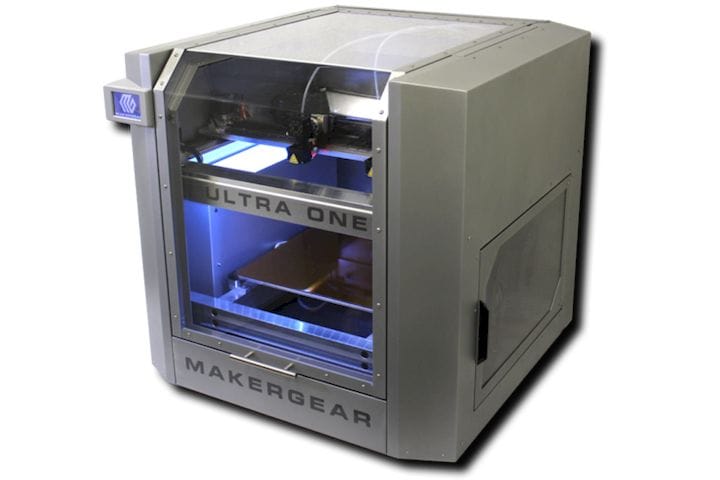![MakerGear’s brand new Ultra One [Source: MakerGear]](https://fabbaloo.com/wp-content/uploads/2020/05/ultra-one-ov_result_img_5eb09c30022f4.jpg)
MakerGear is now shipping a new 3D printer, the Ultra One.
The Ultra One would certainly be the most powerful device yet released by Ohio-based 3D printer manufacturer. MakerGear is one of the oldest desktop 3D printer manufacturers, having been around since 2009, and one of the few from that era that survived the catastrophic consumer 3D printing crash.
They did so by providing quality equipment at good prices, accompanied by great service. Now they seem to be stepping into a new world with the announcement of the Ultra One.
The Ultra One is a large-format, professional 3D printer capable of printing in a wide variety of engineering materials. This device is suitable for engineers, designers and perhaps even low-volume production.
Its build volume is the most visible feature, being a massive 406 x 356 x 330 mm, considerably larger than almost every common desktop 3D printer. The layer resolution is as low as 0.100mm, which is a bit coarser than some other units, but perhaps not a big deal on a machine printing as large as this.
The Ultra One boasts an enclosed build chamber to capture heat, which can max out at 50C. This should be sufficient to enable easy printing of misbehaving materials such as ABS or Nylons. The build plate can reach 140C, quite a bit higher than the default of 100C on most other machines. Meanwhile, the nozzle can reach 300C, again enabling use of many engineering materials.
MakerGear says the machine can support, in 1.75mm format:
”ABS, ASA, HIPS, Nylon, PET-G, PET-T, PLA, polycarbonate, polypropylene, BVOH, TPE, TPU, metal composites, wood composites, carbon fiber composites, and more.”
![The Ultra One’s independent dual extruders [Source: MakerGear]](https://fabbaloo.com/wp-content/uploads/2020/05/image-asset_img_5eb09c305c365.jpg)
Like some previous MakerGear machines, the Ultra One includes its highly flexible independent dual extruders. These can be used in a variety of ways to print multiple materials, speed prints, make duplicates, etc.
What is extremely interesting is the Z-axis mechanism on this device, which seems unlike anything I’ve heard of lately. It’s described as: Four 12 mm rods guide motion independently driven by four lead screws.
Normally the Z-axis mechanism on a 3D printer is one or two lead screws and guide rod(s) to make sure they stay aligned. But there’s an interesting reason MakerGear decided to opt for this design.
It’s for bed leveling.
No, not that bed leveling, we’re talking about real bed leveling here.
Most desktop 3D printers that say they have “bed leveling” are kinda cheating. What they are in fact doing is simply making a topological map of the bed surface at several points to figure out how twisted it might be at that time. Then, when printing, the nozzle simply adjusts its Z-height as it traverses that surface.
The bed isn’t really leveled; the motion system simply accounts for unlevelness, at least to a degree. If the bed’s level is way off, then even this approach cannot compensate for it, and you must actually, physically level the bed. Usually this means turning some knobs or bolts and measuring the height with a piece of paper.
![The Ultra One’s touch probe [Source: MakerGear]](https://fabbaloo.com/wp-content/uploads/2020/05/image-asset_img_5eb09c309cf3b.jpg)
That will not be an issue with the Ultra One, because it includes actual bed leveling. They explain how it works:
“One feature that we’re particularly excited to share is real auto-leveling, where we probe the print surface and then actually level the bed using minor adjustments to the four z motors located at each corner of the bed!”
And:
“The Ultra One features a reliable Touch Probe to determine the levelness of the bed and then provides simple instructions to level your bed, which will maintain its level throughout heavy usage. Additionally, the printer generates a mesh of the print surface before each print in order to compensate for small, unavoidable variations from perfect flatness.”
So they actually do both methods. But other machines only perform the mesh leveling, and require you to manually adjust the physical level.
![The ancient MakerBot CupCake, showing a very dumb four-screw driven platform [Source: Fabbaloo]](https://fabbaloo.com/wp-content/uploads/2020/05/image-asset_img_5eb09c30e9ba3.jpg)
This reminds me so much of my now-ancient MakerBot CupCake, the first 3D printer I built. It used four giant lead screws in the corners of the build plate as seen here, but they were entirely manual and very often they would misalign the leveling. If only the CupCake had the leveling intelligence of the Ultra One!
![View of the Ultra One’s connectivity options [[Source: MakerGear]](https://fabbaloo.com/wp-content/uploads/2020/05/image-asset_img_5eb09c314fa89.jpg)
The Ultra One is quite smart as well. It includes a number of network connectivity options that will be suitable for virtually all installation scenarios, and even includes an onboard computer with 10GB of storage.
I think one of the reasons for the onboard computer is that it is used to run OctoPrint, the standard interface for recent MakerGear equipment. This means you do not need a set-top box for placing the printer in the cloud, as it’s already to go. This also means you can operate the Ultra One from any kind of device, desktop or mobile, as you simply need a web browser.
I should also mention that it is bundled with Simplify3D. This is quite smart, as some of the more devious uses of the dual extrusion system will require an advanced slicing system like Simplify3D.
The Ultra One is priced at a whopping US$12,500, by far the highest price for any device ever produced by MakerGear. However, we’re told it is possible to pre-order it until March 6th and pay only US$9,249, a discount of 26%.
Via MakerGear











FELIXprinters has released a new bioprinter, the FELIX BIOprinter, which is quite a change for the long-time 3D printer manufacturer.